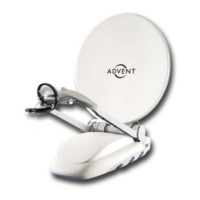VISLINK
Newswift 90-180 Motorised Antenna 46
5.7 ALL SCREWS/BOLTS
Check that all screws/bolts are tight. Use the following torque settings for different size
screws:
Screw/bolt size Torque setting (Nm)
M3 0.7
M4 1.6
M5 3.2
M6 4.7
M8 13.8
M10 27.1
M12 46.7
5.8 RADIATION CHECK
Perform a radiation check around the antenna, outside of the main beam. As a guidance, for
transmit power of 300 watts the power density will not exceed 10mW/cm sq. Measurements
in excess of this may indicate a problem.
5.9 POLARISATION WAVEGUIDE SWITCH (KU ONLY)
Clean any dirt from around the waveguide flanges on the waveguide switch on the
polarisation axis and spray with WD40 or similar. The waveguide should not need to be
removed to do this however if the waveguide is removed the rubber waveguide shims should
be replaced on re-assembly.
5.10 SATELLITE TRANSMISSION EQUIPMENT
Radiation Hazard warnings should be prominently displayed and a safe area around any live
transmissions should be coned off. Normal electrical good practice is to be observed at all
times and all cables, connectors and waveguide couplings should be inspected for integrity.
The following recommended good practise should be complied with whenever applicable:-
Before beginning a start-up procedure of a High Power Travelling Wave Tube Amplifier
(HPTWTA), or SSPA.
Proper integrity/serviceability of the output waveguide system, correct fitment of the
waveguide terminating loads.
Correct operation of waveguide switches and phase combining units.
When transmission with an antenna system is to be carried out, the area in front of the
antenna must be coned off.
Immediately after the powering up of a high power amplifier or SSPA, carry out the following
checks:
A. Check, using a radiation hazard meter for RF leakage from all waveguide flanges.
These must not exceed currently accepted safe microwave radiated levels.
B. Check for any a typical heating of waveguide components, using a Temperature Probe
and Digital Volt Meter (waveguide load will get hot during operation, but interconnections
should not).
C. When transmitting through the antenna system, check that spurious radiations at rear
and sides of the antenna and outside the coned areas do not exceed currently
accepted safe microwave radiated levels. DO NOT PROCEED UNTIL ALL
MEASUREMENTS ARE CORRECT.

